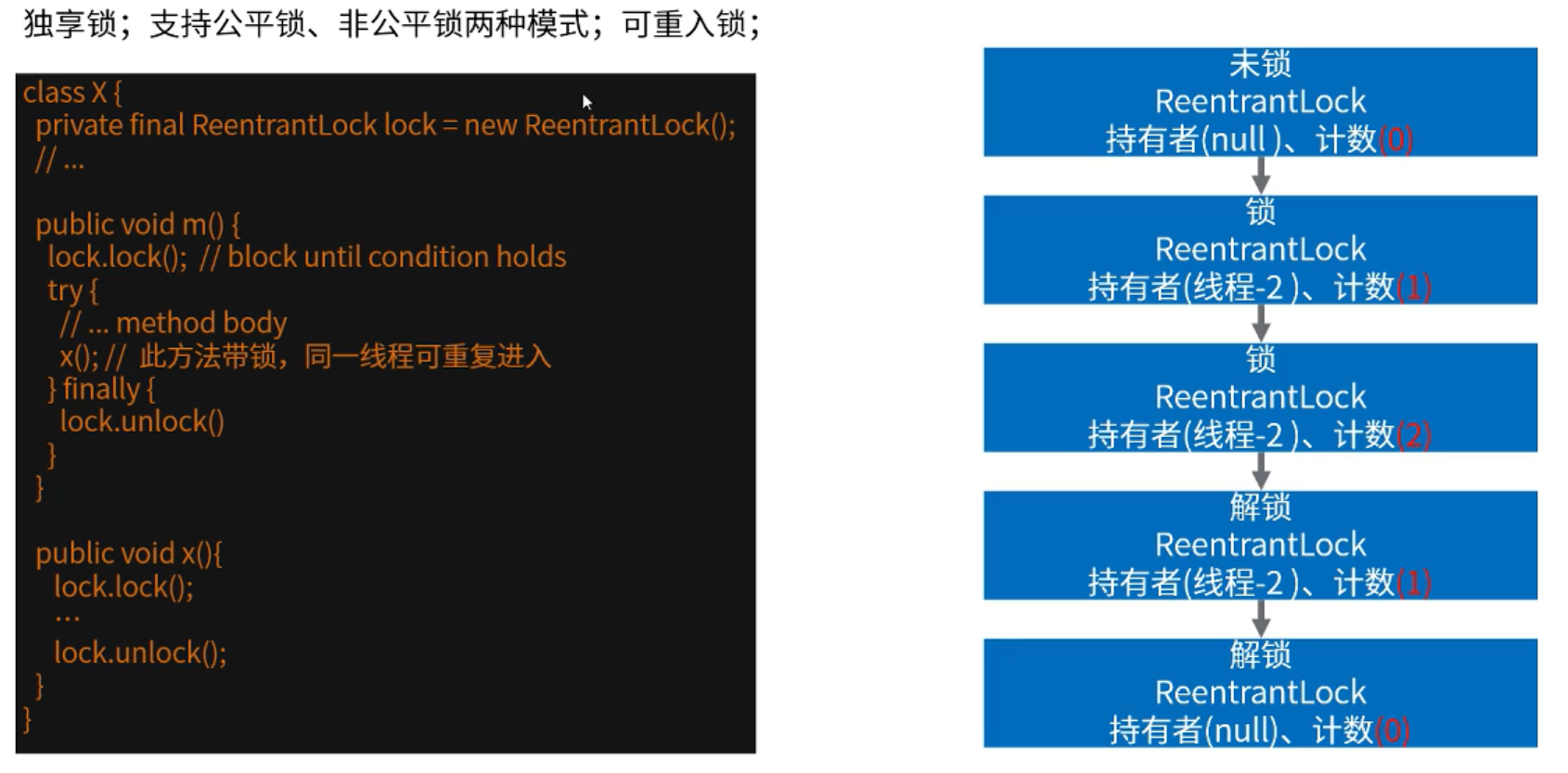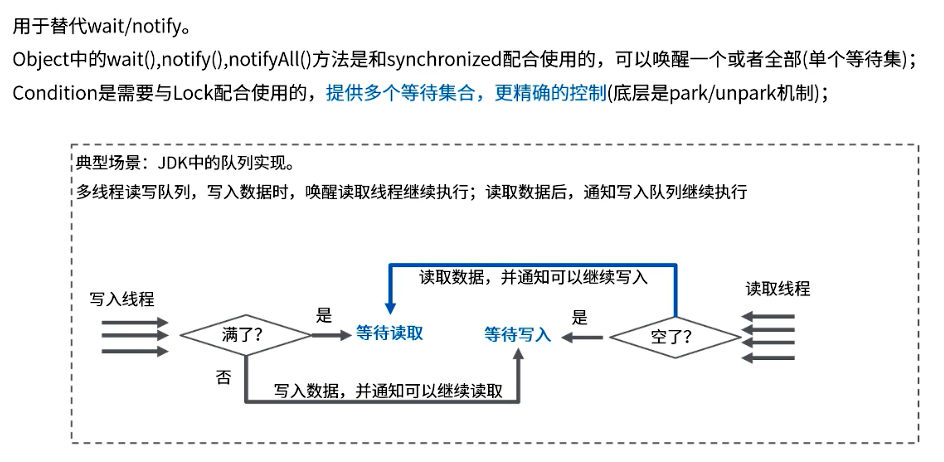主要有读写锁和可重入锁两个重要的实现。
1
2
3
4
5
6
7
8
9
10
| public interface Lock {
void lock();
void lockInterruptibly() throws InterruptedException;
boolean tryLock();
boolean tryLock(long time, TimeUnit unit) throws InterruptedException;
void unlock();
Condition newCondition();
}
|
ReentrantLock
ReentrantLock 实现了 Lock接口,Lock接口中定义了 lock与 unlock相关操作,并且还存在 newCondition方法,表示生成一个条件。
1
2
3
4
5
6
7
8
9
10
11
12
13
14
15
16
17
18
19
20
21
22
23
24
25
26
27
28
29
30
31
32
33
34
35
36
37
38
39
40
41
42
43
44
45
46
47
48
49
50
51
52
53
54
55
56
57
58
59
60
61
62
63
64
65
66
67
68
69
70
71
72
73
74
75
76
77
78
79
80
81
|
abstract static class Sync extends AbstractQueuedSynchronizer {
private static final long serialVersionUID = -5179523762034025860L;
abstract void lock();
final boolean nonfairTryAcquire(int acquires) {
final Thread current = Thread.currentThread();
int c = getState();
if (c == 0) {
if (compareAndSetState(0, acquires)) {
setExclusiveOwnerThread(current);
return true;
}
}
else if (current == getExclusiveOwnerThread()) {
int nextc = c + acquires;
if (nextc < 0)
throw new Error("Maximum lock count exceeded");
setState(nextc);
return true;
}
return false;
}
protected final boolean tryRelease(int releases) {
int c = getState() - releases;
if (Thread.currentThread() != getExclusiveOwnerThread())
throw new IllegalMonitorStateException();
boolean free = false;
if (c == 0) {
free = true;
setExclusiveOwnerThread(null);
}
setState(c);
return free;
}
protected final boolean isHeldExclusively() {
return getExclusiveOwnerThread() == Thread.currentThread();
}
final ConditionObject newCondition() {
return new ConditionObject();
}
final Thread getOwner() {
return getState() == 0 ? null : getExclusiveOwnerThread();
}
final int getHoldCount() {
return isHeldExclusively() ? getState() : 0;
}
final boolean isLocked() {
return getState() != 0;
}
private void readObject(java.io.ObjectInputStream s)
throws java.io.IOException, ClassNotFoundException {
s.defaultReadObject();
setState(0);
}
}
|
独享锁、支持公平锁和非公平锁两种模式,可重入锁。

初始时持有者为null,计数是当前调用lock()方法加锁的次数,unlock()会将计数减1,当计数为0时,则表示当前锁被释放。(获取当前锁的次数 getHoldCount())
可重入锁的话,做了一次加锁就一定要有对应的一次解锁,否则产生死锁。
ReadWriteLock(注:不是Lock锁的子类)
维护一对关联锁,一个用于只读操作,一个用于写入;读锁可以由多个读线程同时持有,写锁是排他的。
读锁拒绝其他线程获得写锁,读锁不拒绝其他线程获得读锁,多个上了读锁的线程可以并发读不会阻塞。多个读锁同时作用期间,其他想上写锁的线程都处在等待状态,当最后一个读锁释放后,才有可能上锁。
适合读取线程比写入线程多的场景,改进互斥锁的性能,示例场景:缓存组件、集合的并发线程安全性改造。
1
2
3
4
5
6
7
8
9
10
11
12
13
14
15
16
17
18
19
20
21
22
23
24
25
26
27
28
29
30
31
32
33
34
35
36
37
38
39
40
41
42
43
44
45
46
|
public class LockDemo2 {
ReadWriteLock lock = new ReentrantReadWriteLock();
public static void main(String[] args) {
LockDemo2 lockDemo2 = new LockDemo2();
for (int i = 0; i < 2; i++) {
new Thread(() -> {
lockDemo2.read(Thread.currentThread());
}, "A" + i).start();
}
new Thread(() -> {
lockDemo2.write(Thread.currentThread());
}, "C").start();
}
public void read(Thread t) {
lock.readLock().lock();
try {
long start = System.currentTimeMillis();
while (System.currentTimeMillis() - start <= 1) {
System.out.println(t.getName() + "正在【读】操作");
}
System.out.println(t.getName() + "【读】操作完成");
} finally {
lock.readLock().unlock();
}
}
public void write(Thread t) {
lock.writeLock().lock();
try {
long start = System.currentTimeMillis();
while (System.currentTimeMillis() - start <= 1) {
System.out.println(t.getName() + "正在【写】操作");
}
System.out.println(t.getName() + "【写】操作完成");
} finally {
lock.writeLock().unlock();
}
}
}
|
ReadWriteLock锁降级
锁降级指的是写锁降级成为读锁。把持住当前拥有的写锁的同时,再获取到读锁,随后释放写锁的过程。
写锁是线程独占,读锁是共享,所以写->读是升级。(读~>写, 是不能实现的)
1
2
3
4
5
6
7
8
9
10
11
12
13
14
15
16
17
18
19
20
21
22
23
24
25
26
27
28
29
30
31
32
33
34
35
36
37
38
39
40
41
42
43
44
|
public class LockDemo3 {
private Map<String, Object> cache = new HashMap<>();
private ReadWriteLock rwl = new ReentrantReadWriteLock();
public Object getData(String key) {
rwl.readLock().lock();
Object value = null;
try {
value = cache.get(key);
if (value == null) {
rwl.readLock().unlock();
rwl.writeLock().lock();
try {
if (value == null) {
value = "XXX";
}
} finally {
rwl.writeLock().unlock();
}
rwl.readLock().lock();
}
} finally {
value = cache.get(key);
rwl.readLock().unlock();
}
return value;
}
}
|
Condition


